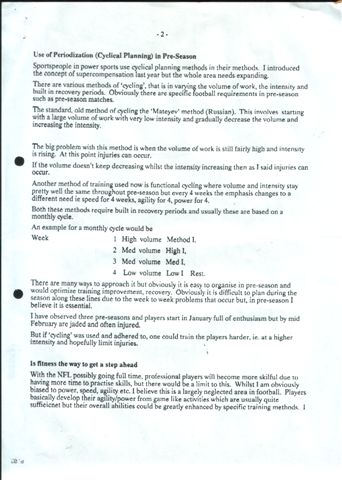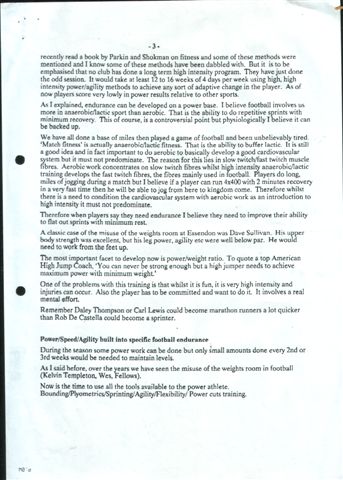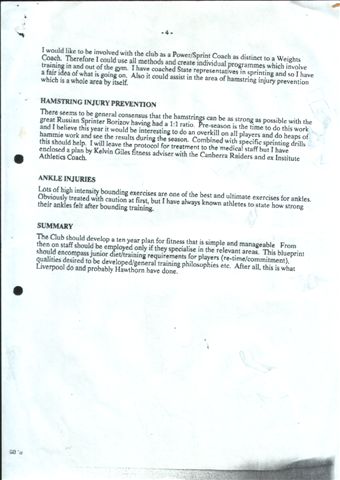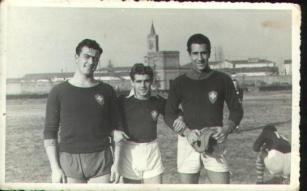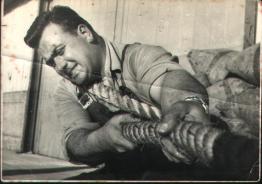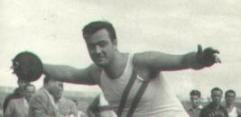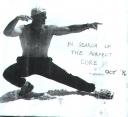Lumbo-Pelvic Control and Running Drills
I recently tweeted a video of Sally Pearson doing a “high knee” drill and suggested that this was a good model for team sports athletes to use as a general guide. Using Dan Pfaff’s term “bandwidth” I think there is a model that intermittent team sports should aim at. The tweet is below.
https://twitter.com/LorisBertolacci/status/1233255452307181569

The explosion of drills emphasizing front-side mechanics means we often see videos of athletes doing contrived “front-side” drills. I also mentioned the lumbo-pelvic area. From what I understand this controls the extremities in a 3 D fashion . We know the pelvis has to move 3D when running but again using the term bandwidth it also has to be an anchor for huge forces to be transmitted through. I could write a book about running drills and another on the lumbo-pelvic area so will keep this article short as possible.
On You Tube we can find lots of nice drills now emphasizing front-side or just run drills. First one is complex and is done well in video. But I assume this requires lots of strength and also skill. Question is will doing it develop strength or will a beginner just do it by flipping the pelvis around?

The second video is an excellent progression of drills and again seems well done by athletes in video ( ie: control pelvis). But we have all seen athletes lean way back as complexity increases to facilitate hip flexion.
Progression of Sprint Drills to enhance frontside mechanics
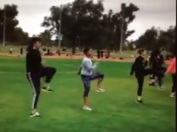
How often have we seen high knees done like the video below in warm-ups. I remember a Volleyball Junior TID camp and they nearly all did this when I said high knees! I thought apart from raising body temperature what poor form for the in-close needs of Volleyball.
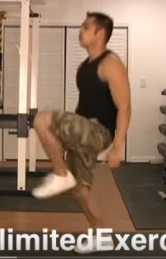
Where it can get really unspecific is when we move to a lot of the front-side drills that involve complex movements, boxes, bars and dumbells. Again pretty good in this video below but I would think this needs a pretty well conditioned athlete with good basic skills in run drills and movement in general. And if we go to an AFL club for example we will still find players who can do this but in reality just compensate again to allow the movements or facilitate hip flexion.
Single leg DB Snatch to Box with Knee Drive
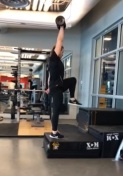
The problem many coaches have in team sports is that they train large groups and do not have the luxury of individualizing. The issue is making the session interesting and the drills varied enough but also sticking to the basics or creating scenarios and constraints to help develop the basics. Dribbling over ankles and calves (modified high knees), mini hurdles, stairs whatever. Whilst speed ladder is not popular with many, some fast foot drills are of benefit with beginners if arms are coordinated and basic postures maintained. I think wall drills can be used with large groups but not for too many reps. This topic alone requires a lot of discussion.
When individualizing though it becomes critical to analyze how an athlete runs, then what their drills look like, how strong are they in general and what lumbo-pelvic issues and range of motion do they have. Also how do they look in a game and are they fit!
One assessment that I believe is valuable is the double leg lowering test. Below are some links. The test can also be done manually with a hand under the lower back and assessing when abs/back can no longer maintain pressure on hand and thus control pelvis.
VID: Double leg lowering abdominal test
Double leg lowering test: Article
https://www.topendsports.com/testing/tests/abdominal-strength.htm
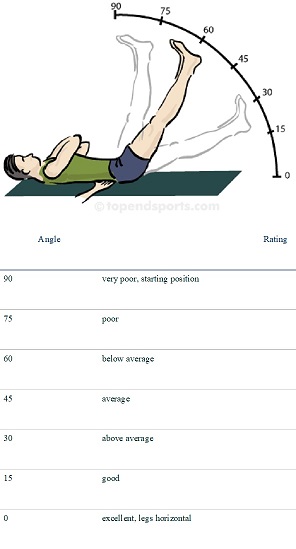
The ability to control the pelvic or fancy word (lumbo-pelvic) can and should be assessed by many means. Sorensens test ( holding a back extension), side oblique holds, single leg hamstring holds and so on. The problem or weakness could be multifaceted. Stuart McGill has some excellent tests and data which in my opinion combined with the double leg lowering test will provide some ok indicators to drive what ‘core” work athletes need or to explain why things are breaking down in running drills relative to this article. But for runners I think wise to add the leg lowering test because the McGill tests do not seem to address the impact of leg levers on pelvic and lumbo_pelvic area.


Personally I have found an inability to perform well on this test usually co-incides with an inability to hold postures in areas like sprint drills. (just like an inability to do single leg swiss ball hamstring curls!).
There are regressions and progressions to this assessment galore. Below are some excellent links
https://thebarbellphysio.com/core-movement-every-fitness-athlete-needs-master-optimal-performance/
Dead Bug Progressions: Prehab Guys
https://theprehabguys.com/advanced-core-exercises/
So what do elite athletes do for lumbo pelvic stability. Hardcore S&C people will say squats and deadlifts and overhead lifts will stimulate the “core” and enough. Others do heaps of offset walks with dumbells and some pallof presses. Many elite athletics coaches keep it pretty basic and work all angles with all types of ab exercises, hanging knee raises, lower back work and medicine ball work. Here is Sally Pearson doing some good old fashioned med ball work.
Sally Pearson Medicine Ball Ab Training
But I am sure that if I tested her for double leg lowering strength she would get a good result. Experienced , successful and astute coaches know how to condition athletes in the lumbo pelvic area and intuitively know when the link from run to drill to conditioning is missing and how to fix issues. Many young “INSTAGRAM” coaches do random fancy shit.
But take home at individual level some assessments have to be done, and then tied in with what is seen on field in runs/drills/jumps etc and under fatigue.
This area is massive! The research on injury prevention in soft tissues (hamstrings) is exploding. We have moved from eccentric needs to now hearing the word running technique and “lumbo-pelvic” being spoken about. The moment you speak about anything in isolation though forget it.
Getting back to my video on twitter with Sally Pearson and running mechanics for team sports athletes. With big groups KISS method and stuff like short hills/hurdles/light sleds/walls etc can create constraints that develop OK technique and postures. ‘Core” routines for big groups should be aimed at the middle levels. “Do no harm” but get some stabilization going. At individual levels for coaches tease out what is the issue. But also do some assessments such as the double leg lowering test or sorensens tests and see what they can cope with.
Visually I use content such as in video below because it seems to reinforce good posture and basic skills.
Fast Leg or “dead leg” Run Drills
As I said this topic is one that needs a book or more research than has been done on the nordic exercise!
SKILL BASED CONDITIONING. IS IT ENOUGH? NO!
Small sided games and fitness through games has really made its mark in team sports training. Lot’s of work filtered through from Hockey and other sports and in AFL we saw the Adelaide Crows pioneer this approach. Nevertheless they used other means (for example ergometer work) to supplement fitness, but less formal running. But has their high injury rate occurred due to high fitness levels and poor motor patterns? Who knows? This is a bad mix and at the base of my discussion. This approach has filtered through to many sports and recently we saw a research article by Gabbett on Volleyball with juniors. Obviously “bang for buck” in simplicity is far greater when things can be combined but my opinion is that there is a downside to what seems a simple solution to fitness. Yet I have seen many problems with this approach.
We have seen an explosion in sports science in Australia and a huge influence on sports such as cycling and rowing for example. Team sports have achieved enormous benefit due to sports science, with areas such as load management, heat management, hydration and many other areas receiving enormous backup. Huge factors and load management has been a big one with GPS and databases etc.
Sports such as soccer are now creating skill based TID schemes where kids are encouraged to play heaps of games and learn lots of skills early and then they are selected later on from a larger pool of skilled players. Simple.
But we have direct evidence that the relative age effect destroys the careers of many young players and only the gifted younger ones come through (and in fact succeed more often) coupled with kids with advanced maturity that sneak through. So many good kids are left behind. That is kids that are born early and who survive due to talent, do well at elite level. On the other hand the “bruisers” with no talent also do well as well as older kids. So many young (born early) players are lost and this is mainly a physical factor due to maturation and/or training.
And look at Tennis. We have a massive generation of players whose parents have mortgaged their houses for coaching and yet no result so far.
Sports Science has been little assistance to track and field. The scientists would say that the coaches do not want to listen. But my opinion is that the sports scientists have little to offer because very few really know how to create advanced athletes. Sports Science is awesome at telling us how to manage a player in Malaysian heat but has little idea how to propel someone over 2 45.
In team sports like AFL we simply aimed at the average. One needs to be good at many areas. Intermittent sports require a broad long term base of conditioning and good acceleration and a sufficiently developed aerobic system to assist repeat efforts. Average to OK in the gym and average to OK in power. All achievable and in the end injury management becomes a key as does talent. My experience in all these team sports is much the same. One usually does not need to create super athletes. But if a team has a core of players who have talent and also have developed all their fitness skills (running/jumping/change of direction etc) then that team should always beat a mob that can play and are fit but lack “fitness” skills. Always the same principle. All things being equal, one factor will make the difference.
Getting back to tennis, my opinion is that strength and conditioning and fitness are simply massive factors why we are falling behind in many sports. And this needs to happen early. Puberty. And by then kids should be fully developed in all facets of running and jumping and change of direction and also have a broad base of conditioning. What we see in OZ is a huge number of skinny kids with good aerobic qualities and one sided bodies coming up against explosive “Europeans” and now Asians. Forget what happened 30 years ago. No one played tennis.
And with all due respects let’s not really consider many sports in OZ like netball and cricket and AFL because they are not played on the world stage. Our female basketball improved when they started all going OS. So there is nothing to compare here. Even Rugby League is limited in exposure. Rugby Union is only now starting to go PRO all over the world and we will see the effect of that in ten to twenty years.
In Athletics we do not have coaches for kids. Kids are not taught. There are other problems but it is difficult to change bad habits. In AFL usually paid and competent fitness personnel spend 2 to 3 years fixing up massive deficiencies in players from 17 to 20. And that works and we see a reasonable product by 21. That’s ok for footy and then add some skills based games for fitness and VOILA …Fit and at 25 yo the team wins games.
We have seen the push to work a lot on agility versus change of direction. But my experience was that the freaks (e.g. Gary Ablett) had it all. Ability to change direction, balance and then vision and skill.
In Volleyball all I see is skinny little frail kids jumping around and getting fitter BUT reinforcing very poor “fitness” and neuromuscular habits. Once ingrained hard to change. And Volleyball is a real sport. Played everywhere. Lot harder to succeed in than cricket and netball and AFL. So strength and conditioning at an early age is now in my opinion an absolute priority. We must have players ready at 16 to 18 to explode on the world stage. In AFL they usually cannot squat with a broomstick at that age and it doesn’t matter. One has time in the cloistered environment of AFL. But in tennis and athletics and volleyball and soccer, there is no time. Be good early or perish. So know how to play the sport, make decisions on court, do the clean and jerk and bound through the roof. Not balance on a swiss ball.
I have spent 15 sessions with an elite junior soccer team (12 yo) and have done 45 minutes a week of running technique and core and balance work. The results have been great and now many players are starting to challenge other players in state teams from other clubs. The coach says they are more explosive, balanced and change direction. Add skills and decision making and a talented player assumes their right position. And the young boys like doing it as long as they are not being flogged and they are learning and having fun.
The skills based approached in my opinion can be lazy. Simply get heaps of kids doing the sport and see who comes through. Chuck them a ball and let them play. Of course they will get fit.
It is obvious that one has to learn the sport early and learn to make decisions. We know that multi lateral development is the key at least till puberty. But the missing link is strength and conditioning and movement education at an early age. And core development and balance.
Of course if I get kids to play all day at 100% pace in the backyard chasing dogs and jumping fences they will improve in their vertical jump and 5m tests. But we need to slow down and realize that life aint that easy, and ask the question why we struggle in so many sports.
I think sports science has to slow down a fraction and ask the question “Can I get a male volleyballer to vertical jump 95cm?” or a tennis player to explode sideways and drop their centre of gravity and smash a forheand back to NADAL. Having good salt balance in a drink at Wimbledon will not help if you cannot get to the ball.
Let’s remember that the best coaches are ones that combine ART and SCIENCE.
I love sports science and in fact if we can attend to the strength and conditioning issues at a young age and have skilled kids ready to go at 14 to 16 we will dominate the world. My opinion.
So in summary.
Do everything in development. Zero shortcuts.
And forget non-international sports and non eccentric sports (circling/ rowing, swimming, kayak etc) when comparing and or using sports science.
Ciao
Loris
HAMSTRING REHABILITATION E BOOK
Available on my website now
Loris Bertolacci Site
http://www.bertolacci.com.au/LorisBertolacci/Welcome.html
This E Book is a complete resource for anyone that needs to devise practical programs for hamstring rehabilitation. It delves into the current research on this area to back up the programs.
This 120 page manual includes over 150 Exercises and 8 different programs including specifically designed Running, Agility, Stretching and Weight Programs to help any athlete get on the road to a safer and more sound recovery.
Section 1: Hamstring Theory
-
•Introduction
-
•Anatomy
-
•Overstriding and Hamstring Injury
-
•New Studies Implicates the Core in Hamstring Injury
-
•Other Muscles that Impact on the Hamstring
-
•Hamstring Exercises
-
•Why Injuries
-
•Trunk Stability and Hamstrings
-
•Different sports and Hamstring Rehabilitation
-
•So what do you do if you hurt your Hamstring?
-
•Healing Times and Rehabilitation
Section 2: Practical Section
Program Advice
-
•Sample Sessions
-
•Mobilization Sessions
-
•Running Sessions
-
•Mobility Drills
-
•Running Drills
-
•Running Sessions 2
-
•Strides
-
•Agility Sessions
-
•Weights Sessions
-
•Stretching after Training
-
•Plan your own rehabilitation
HAMSTRING REHABILITATION AND HEALING
Soon I will publish an E Book on strength and conditioning programs after a hamstring injury. Specifically soft tissue and not back related etc. One area that seems to cause problems is athletes working too intensely too soon after a muscle injury is diagnosed and taking gambles. Jarvinen’s review emphasizes the need for 3 days immobilization to allow healing as a critical phase. Respecting the stages and phases of healing in soft tissue injury is vital. Some researchers categorize these stages differently. From acute ( inflammatory) up to 7 days to proliferation ( 7 to 21 days) and maturation and remodelling ( >21 days).
Not respecting healing dogma is fraught with danger given that means trying to beat nature. Programs in my e book are based on this dogma. And Jarvinen is very clear about the processes involved.
I was lucky to work in the AFL for 20 years and since 1999 till April 2006 I was operating at approximately half the average games lost for hamstrings in the AFL. I coached sprinters in the 80’s and simply spent a lot of time researching and working this area.
HEALING MUSCLE INJURIES
Muscle Injuries: Biology and Treatment: Järvinen
The American Journal of Sports Medicine, Vol. 33, No. 5
This study emphasizes the need to immobilize in the acute phase which as minimum from healing studies should be 3 days.
REST IS CRITICAL IN THE ACUTE PHASE!
Even slight use of the injured muscle in this Acute Phase needs to be avoided according to Jarvinen. He also talks about reruptures at the same site if mobilization is too soon. By resting in this phase less scar is put down.
WHAT HAPPENS AFTER THIS IMMOBILIZATION PHASE ?
PARADOX: Use it or lose it!
The rest in the immobilization phase allows the scar to get some strength. In fact after 10 days the scar is quite strong
After the immobilization phase is over then active mobilization enhances the penetration of muscle fibres into the scar tissue, limits the size of the scar and aligns the regenerating muscle tissue.
“If immobilization is continued past the acute phase (first few days) of muscle regeneration, the deleterious effects become particularly evident during the remodeling phase of muscle healing”
Lauren Bertolacci comments on Womens Volleyball in Australia
August 09
Germany
I’ve arrived, I’ve settled in and I’ve trained. And I love it. The environment and atmosphere among the girls is one of hard work and with a central goal in mind. Everyone us positive and pushes each other at training. The group a a general rule is quite young, and big. Our middles are fast, and both us setters play a similar game. I’m really looking forward to this season and I think I will take a lot from it. The level isn’t as big a drop from France Pro A as i expected, and I think a lot of that is due to the attitude of the girls here, its still a very fast, powerful and skilled game.
Just to clear a few things up, I’ve been reading and hearing a lot of negative things about the new Australian womens program, or lack of it. OK, so the program isn’t the AIS, there is no full time training just yet, the group of girls selected is a totally fresh and unexperienced group, and the AVL was on occasions a little bit scrappy. But lets put this into perspective hey. The program broke down at the end of 2005, there was no full time training anymore, and the girls that were there, only three were playing overseas getting that training somewhere else. A camps based program was put together, and a team selected for world champ qualifiers. A massive effort and with a few things against us, we lost to Taipei in a very close match and didn’t progress. 2006, there was no FIVB tournaments, and thus pretty much no program. We are in a phase of rebuilding now, it happens, you can’t be at the top of your game forever, players retired, moved to beach, and it leaves holes in a team. To say that we are not heading in the right direction now is totally wrong and unfair. We are not as strong a the team of 5 years ago, I don’t dispute that. But this group, including the new head coach, is trying to build a new culture in womens volleyball, and you have to start somewhere. That is now, the AVL was a success, especially considering it was in its first year and every team was a new group thrown together who hadn’t played together before, and in my opinion, put on a decent show. We are heading in the only direction we can, and that is forward. Right now this group needs positive people behind it, its young, inexperienced, but has a passion for the game and to build a new and successful program. You can’t ask for anything else at this stage, and we will prove we can do it. The program will build from here, hopefully into a fulltime one, and womens volleyball in Australia will follow and progress into a much bigger force, that younger players will aspire to be involved in, and we will grow from there. I don’t argue that we have gone backwards in previous years, but from here, the only way is up.
Secrets of Loris Bertolacci
This is from 1988 and I wrote it at Essendon Football Club so all history now.
Also I am not sure if anyone read it. I would write these things then shelve them. I must admit I was always very impressed with Brian Donohue who was Sheedy’s right hand man. He always listened intently to what I had to say and really embraced concepts like 3 weeks hard and one easy. Also he was computer literate and kept strict statisitics well before John Orchard did anything. And they were very well organized. He was ahead of his time.
These sheets are a bit like the dead sea scrolls, really but I hope of some historical interest given the development at the time of the 1990 team and the 1993 flag and the implementation of these concepts in those days long gone now that Hird and Sheedy are ready to go.
Hard to read but if of interest have a look. In a way all stuff volleyballers should do in theri development anyway.
I was giving Mateyev a bad wrap in 1988. And functional cycling then was hot off the press from Bondarchuk. Track and Field training techniques were miles ahead in the 70’s and 80’s. In fact all that has changed now with sports science and the information revolution is that lots of fine tuning needs have been studied that help the specific needs of individuals and situations like heat stress and osteitis management for example. These developments are fantastic but the basics remain.
And long term physical development of juniors. HA. Big business now!
George Bertolacci
My dad loved sport. Talk about functional strength. He used to grab 100kgs at 45 and stand there and military press it for rep after rep. Then he could press me overhead. At his heaviest he was 155kgs and at his fittest was 110kgs. Big.
When I trained in Italy , all his mates in Livorno ( near Pisa) used to tell me about how he was the best arm wrestler going around and how they used to bet on Giorgio in the bars. He had massive wrists and even at my strongest he killed me.
Dad played Rugby Union in Italy with Livorno and was the kicker. He also played representative water polo and was a very good swimmer. He represented Tuscany in Athletics also and did a stint in graeco roman wrestling. All at state level.
He had a game or two of Aussie Rules in 1952, I think with Reservoir and kicked a few with place kicks. He came out to OZ in 1951 ! Apparently he replaced a player who went to Essendon so the story goes. He only had been in Australia for a year but had worked with the Americans in the war and so spoke English. He even had a training run in February with Fitzroy the next year, after a game with Reservoir and rode his bike to the wharf for work then back to the Brunswick Oval for training and promptly did his hamstring badly on the first night of training. So he started athletics again and competed with Coburg. He represented the state in the throws after that and was the anchor man for the wharfies at Port Melbourne and this shot was in the Herald Sun of those days.
He played Table Tennis a lot at a high standard and at 130kgs used to play against 50kg Asian guys at Albert Park. He had a short temper so sometimes the bat went flying and his opponent was in fear of his life.
He did a lot of soccer coaching in the 60’s until he started coaching me in Athletics. He started me in shot put in 1967 and I boomed. But like so many young people by 16 I knew it all and went on a long distance running binge to lose weight and as he had told me would happen, my throwing career faltered.
The last athlete he coached was Saverio Rocca in the discus and the big Sav had to come to my dads house and tell him that he was playing with Collingwood. I could see Saverio was nervous and dad was not happy. After all Sav was a better athlete than he was a footballer and I think dad knew he had lost a huge talent. Before that he coached many athletes and the best was Paul Nandapi. Paul won a heap of titles and medals in the commonwealth games. But with dad at 16 he was throwing mid 50’s with a senior discus and almost 17 metres in the shot put. Then he went to the AIS at 18 . Dad had a real knack of getting young athletes up and he won so many championships over 20 years. He never overtrained them and always made it fun. They sprinted and jumped and did a bit of everything and not too much of anything. It worked. The AIS sent him a plaque years later for his contribution the sport
He started the second pizza shop in Melbourne ( GIPIS) after TOTOS and one day 2 drunk guys came in and started a fight. I ran in and they knocked me out. I was 16. He grabbed them both and threw them in the car and when I came to, made me hold them and we drove to the police. One was the middleweight boxing champion of Australia. One chap once grabbed a pizza and ran out, and dad at 45 sprinted out the shop and ran down High Street and rugby tackled him to the ground. Big fast twitch man. The thief coudn’t believe it. Lots of Fitzroy players lived in the Northern Suburbs and they came to GIPIS after a game. Dad was a great sketch artist and would make funny sketches of players like Gary Wilson.
We always had sportspeople around our house. Kevin Murray ( Fitzroy Captain) lived up the road in Reservoir and was a real friend of the family. Whenever Italian sportspeople would come out to OZ Dad would seek them out and invite them home and Mum ( Rosa ) would cook them a treat. Fencers, athletes, boxers. All world class sportspeople at our house. I remember once dad picked up this boxer who was going to fight Johnny Famechon as he marched to a World Title. The boxer was from Livorno ( dads town) and in the car he told us he was retired ( Ex – European Champ) and was out only to earn some money and help Famechon get up the rankings!
I think a special day was Sundays at the Bertolacci house. We would train at the Preston Athletics Track at Edwardes Lake. Often some good throwers would appear to train with us like Matt Barber and Phil Nettle and other behemoths. They would come home to Lunch with Paul Nandapi and a few other big guys and mum ( Rosa) would have about 100kgs of pasta ready and 189 Schnitzels and bowls of potatoes and so on. They ate and ate. I watched in amazement. Then they went in the lounge room and watched World of Sport and fell asleep. When carbed up they would the weights on Sunday night.
Once Saverio went to Collingwood , dad decided to wrap it up and I wish he had kept coaching. Kept him switched on and a step ahead of diabetes. After that he moved to Rosebud and lost touch with coaching and fell into ill health. Rudy Villani my cousin ( and a great athlete) said at dads funeral that George had given us our love of sport and an appreciation of all sports. He loved to watch great athletes and loved all sports ( loved AFL) and this was very important for our overall sports development.
Thank god he died before all the crap was written about me in the media in 2006. Mum and Dad would never have understood it and to be honest nor have I. Had nothing to do with sport dad. But one thing that dad left me was a love of sport, and that remains and I will coach and produce athletes and high level performance just like he did .
AFL , Patrick White , Drugs and Tour De France .
I was listening to a debate on drugs in sport ( Tour De France mainly) on SEN today with Patrick White and it was frustrating. The whole area is so sad. My main concern really is the recreational use of steroids in local gymnasiums in Australia. People make money out of naive men who want a quick fix with muscles and don’t know what they are doing. Huge health risks await them later in life. That needs to be addressed with a massive educational program with kids.
I find the debate on drugs in sport so difficult. AFL players in a sense are not elite athletes. They are awesome all round athletes, but they are measured by wins and losses and statistics and coach appraisals. Not by having to squat 230lgs, for example, to improve their performance. What I mean is that usually AFL players do not directly link training statistics with performance. AFL players in general don’t come to you and say I want to run 9 mins for a 3km or squat 200kgs. ( Some do of course!). And this is because the link between improvement in training variables and performance is not as clear as many elite sports.
Elite athletes directly know that if they can increase a few measurable variables in their training they will improve. Also with AFL there are so many areas to improve and one plays a juggling act with it. Get too big and strong and endurance suffers, but run too much mileage and speed suffers and so on. So most players are good at everything without being special at anything. And the ability to repeat speed is at a premium and this is not a specific trait.
The debate about whether anabolic agents could assist recovery and rehabilitation is that, a debate. But the season is long and again nutrition and recovery methods win out in the long run.
There is no doubt that steroids were sneaking into the AFL in the 70’s and the 80’s. Too long ago and who cares but it was on the increase and thats that. So ASADA and the AFL has done a good job.
But from a philosophical perspective I always cringe when players get jabbed before a game with a “legal” painkiller. A drug is a drug. So once caffeine was made legal then it was ok to pump those NO DOZ in like lollies. But in the “old days” if caught with 6 short blacks you were tainted a criminal. I got dragged into the media because Darren Bewick took 2 NO DOZ before a game in 1998 when he had the flu and became sicker and I didn’t even give them to him. It was huge, and luckily the Alistair Lynch “scandal” was on at the same time.
This is the same situation that occurs in Society. Alcohol is legal and if you don’t drink and drive you can get totally drunk and thats ok. Weird.
My main worry with steroids is health. I support drug testing because I wanted to compete drug free but one is naive if people think sport in Australia is drug free and that one sport is cleaner than the other. After all there are so many ways people get around the system that really who knows half the time what is going on.
The media goes in hard when there is a sniff of drug cheats.One see pictures of people caught on drugs and they look like mug shots. I would go in harder when club officials are caught drink driving. But I am a cynic and that doesn’t sell papers.
Below is a transcript of a radio interview with Warwick Hadfield that I did a few years ago and the link to ABC.
http://www.abc.net.au/rn/talks/8.30/sportsf/stories/s1138355.htm
Program Transcript ( June 2004).
Warwick Hadfield: The big issue this week is once again drugs in sport, but this time it’s in Australia.
Loris Bertolacci: From ’75 to ’82 both here and overseas, by a number of coaches and in a number of situations in capital cities in Australia, and round the world, I was encouraged to take drugs.
Warwick Hadfield: Were some of these coaches attached to the Australian Institute of Sport, or similar official positions at the time?
Loris Bertolacci: I think I will leave it at the fact that there were a number of coaches from ’75 to ’82 that I think as a general interest in that it came from me because they saw me as a potential talent to take drugs. I don’t want to say they were attached to any official – you can actually work that out for yourself.
Warwick Hadfield: That’s former hammer thrower and now leading Australian football fitness co-ordinator, Loris Bertolacci, a member of the first intake of athletes into the AIS back in 1981.
I put his allegations to the Australian Sports Commission. A spokesperson said that without the names of the coaches, those allegations had no credibility. The spokesperson added both the Commission and the AIS have and will investigate all credible allegations brought to them.
Bertolacci’s claims come to light as just 49 days before the Olympic Games, Australia finds itself embroiled in the biggest drugs scandal in its sporting history.
This week sprint cyclist Mark French received a life ban from the Australian Olympic Council, after being found guilty of possessing two banned drugs. He has appealed against that ban, saying he wants to clear his name.
The Federal government has also set up an inquiry into allegations five other cyclists were involved in using the banned drugs.
There is, however, no evidence on this occasion that AIS coaching staff are involved.
Back in the 1970s and 1980s Loris Bertolacci, now 50, made the decision to resist all the urgings and compete drug free.
Loris Bertolacci: There were two very firm reasons for me, that was the critical factor was one was health, I always was a strength power athlete and people that knew me that liked to go for a run didn’t really want to put on much weight and thought about the long-term. So it was health. There’s probably three reasons. The second one was I found it particularly boring that people with sometimes a lack of talent could improve so dramatically in the gym and on the track and that. And let me preface that by saying that there are some genetic talents that didn’t need drugs that did perform admirably, and that’s the unfortunate thing.
Warwick Hadfield: What do you mean by that’s unfortunate?
Loris Bertolacci: Well it’s unfortunate for those people because some people that are genetically talented, and we see them in footy obviously Wayne Carey and these people here, they actually are far better. There’s only probably ten great players or five great players in the AFL, and they’re talented, they’re genetically talented, they’ve got skills, so therefore they perform above the level of the others. The same in track and field, weightlifting, whatever, you do get the odd ‘freak’ or people with genetic endowments that does perform at a very, very high level, and then unfortunately they get tainted with drug use, and certainly I wasn’t a genetic talent, I was just a very, very strong guy, naturally. The other thing was that I had an intense desire, and people that know me would understand this, to train as hard as I possibly could for ten years and beat the guys on steroids, basically by just being stronger and harder than them, because I just didn’t like the scene, really.
Warwick Hadfield: Does it frustrate you though that many of those people who did take the steroids are now regarded as – well, their records still stand 20, 30 years down the track?
Loris Bertolacci: Well first of all it was my own fault for retiring at 26 for personal reasons. I could have actually thrown a lot further, so I’m not going to blame it totally on steroids. But I did back myself into a corner a little bit and whilst I could have improved, there were some people that wouldn’t have been as good as me, I’m convinced about that, that now probably rank higher than me in certain areas, and there’s certain people that didn’t take steroids that performed a lot better than me too. So I’m not naïve.
Warwick Hadfield: All these years down the track though, some of these people who you knew to take steroids are not in the same good health that you’re quite obviously in right now.
Loris Bertolacci: Yes, look, I’ve met a lot of people in the past from gyms in sport and everything like that. I found it’s had an impact on their health. That is a huge factor in this whole area, and it’s a bit like people that take X this year at 30, they’re finding they’ve got symptoms of Alzheimer’s, or people that drank themselves into oblivion through their 20s and are in health now. I’ve seen people that I work with in gyms, clients that were in gyms 15, 20 years ago, bouncers that really rue the fact that they did this now and have high blood pressure and problems with thyroids etc. etc., and even some further health problems. I think that’s a major impact later on in life when the thrill of the chase has gone.
Warwick Hadfield: So why, there’s been testing for years now, it’s very, very high profile, all the side effects are well known as well. Why do you think even now, all these years on, people like what’s happened at the AIS, the cycling, in the last few weeks; why do you think people are still taking these incredible risks with banned drugs?
Loris Bertolacci: A number of reasons. I think, I certainly thought about it, I can understand the psyche because you do want to get into the top 10, top 50, top 20 in the world, you do want to go to the Olympics, you do want to wear the national tracksuit, you do want to achieve something, it’s a lot different competing in a windswept velodrome in, well it used to be Brunswick didn’t it? against going overseas and to an international thing. So the lure of the international circuit. There is money, and certainly instead of actually having to work in a mundane job, a lot of these guys can sustain their life for ten years. And it’s just that intangible that people are after, they just become very desperate, and they close their minds to the risks. And it’s probably a folly of youth too, in some regards, and an irresponsibility of people that are attached to them, i.e. I’m saying coaches quite possibly here, who you’ve got to lack respect for them if they condone this, because we have a huge responsibility to our athletes here.
Warwick Hadfield: What about the sports though which have been clearly identified as where drugs are abused: cycling, it’s emerged, the power sports, weightlifting and hammer throwing and so on. Will a time come when parents might have to say Well if my child pursues that sport, they’re going to have to make this tough decision about drugs, and parents may need to take responsibility for pulling their children out of those sports.
Loris Bertolacci: Certainly you have to worry if you’ve got a child that’s veering towards those sports and has an intense, fanatical desire to improve. You do have to worry about their future involvement.
Warwick Hadfield: The story from the AIS in South Australia is of a shooting-up room. Is that something that you’ve seen in your experience in sport in the past? A room where people go to inject themselves rather than have it done by doctors with illegal drugs?
Loris Bertolacci: I think unfortunately yes, certainly here and overseas, time and time again before national titles or in different places etc. and even overseas, and with professional assistance without, and unfortunately now just as we see people can go on the internet I suppose and work out how to construct a bomb, I think that the flow of information in society now, from every aspect is massive, and the ability to get what you want is very easy. So I think it’s a bit naïve of people to think I would assume that things have actually tightened up.
Warwick Hadfield: Former hammer thrower, Loris Bertolacci.
This is The Sports Factor on Radio National. I’m Warwick Hadfield, and this week, the scandal that could destroy Australia’s reputation as a world leader in the fight against drugs in sport.
The two banned drugs found by cleaners in Mark French’s room at the AIS cycling annex in Adelaide were testicomp, also known as glucocorticosteroid, and Equigen.
Testicomp is an anti-inflammatory and only attracts a minor penalty if used by sports people.
Equigen, a growth hormone for horses is, like all growth hormones, banned by the International Cycling Union and the World Anti-doping Agency.
Dr Sue White is a member of the Australian Sports Medicine Drug Advisory Council. She explains why a product meant for horses might have suddenly become attractive to athletes.
Sue White: The actual fact that it is an equine growth hormone means that it doesn’t have the same restrictions as human growth hormones to access. To get human growth hormone in Australia and certainly overseas, there’s lots of restrictions on it placed through the government, placed through the prescribing organisations. Those conditions don’t exist in the veterinary world, because this drug is not a banned drug from their perspective, and so you would be able to access it through fairly standard means and I also believe that it is not particularly expensive.
Warwick Hadfield: So what else do we know about Equigen?
Sue White: Well the things that we do know are basically that it’s a veterinary drug used in horses and it’s specifically a horse growth hormone, and we certainly haven’t been aware in the past of anyone trying to use it on humans.
Warwick Hadfield: What would it do, what are the things that it does for horses that might benefit humans who are competing?
Sue White: Certainly the things that it would do for horses, they would get improved muscle mass, potentially decreased body fat, there’s certainly been no specific discussion on whether it is ergogenic, which means it actually increases the power output or the aerobic capacity, but certainly the body composition seems to be the primary effect. But the interesting thing in this case is that we know that growth hormone is quite species specific, so we know that certainly growth hormone in pigs is specific for pigs and it is more than likely that growth hormone for horses is specific for horses. So in fact these athletes may have been using this medication without any effect at all, except possibly negative effects.
Warwick Hadfield: One of the reasons we don’t know that is that there are ethical reasons for not actually testing this drug on humans, so the athletes are able to test it on themselves, but the testers, the people who are trying to catch the athletes out, haven’t in the past been able to go out and see just what it might do.
Sue White: There’s lots of problems with researching drugs in sport. One of them is some of the ethics, even with the drugs that are prescribed for humans, using those on people that don’t have the actual medical indications for that drug, it becomes even more of an ethical issue if you would like to try and test humans with products that are designed for animals, and I can’t imagine any Ethics Committee agreeing to allow that to happen because of the potential side effects.
Warwick Hadfield: Are there at this stage any known side effects of humans using this drug?
Sue White: Well because we don’t know of humans using it in the past, no, we don’t know. There’s certainly been debates about the use of animal products or drugs for animals in humans in the past, and some of the thoughts have been things like the production of abnormal antibodies, possibly if it does have an effect in humans, then it could have similar side effects to human growth hormone, which is a condition called gigantism, where you get increased bony structure in the face, increased hand size and certainly problems with some of the internal organs.
Warwick Hadfield: One of the reasons that athletes tend to use the growth hormone that’s made for humans is that it aids recovery. Does this horse hormone do the same thing?
Sue White: Well we still don’t know if it does that in humans. In horses, it’s mainly prescribed for ageing horses, so certainly improving recovery would be one of those things, but there’s no indication at this stage that it would be doing that in humans.
Warwick Hadfield: What are the broader issues here in terms of Australian sport? We’ve valued ourselves as being pretty clean in this area. Is this going to do damage to Australia’s international reputation in the fight against drugs?
Sue White: I think any time any of our athletes are involved or appear to be involved in an issue such as this, I do think it damages our reputation, and as we’ve always said, it’s unfortunate that we hope that it’s a small group of athletes, but it does tend to reflect upon all of our athletes.
Warwick Hadfield: Is it sports-specific? Are there some sports where drugs are more notoriously used than others?
Sue White: There’s no doubt that there are certain sports that have more benefit from using drugs, and they tend to be power and strength sports, and endurance sports. So many of the track events, many of the field events, swimming, cycling, but things such as synchronised swimming or diving that are perhaps more subjective in their judging, not just a pure number at the end, but possibly involve some more specific skills, are less likely to benefit from drug taking.
Warwick Hadfield: THG, human grown hormone, was supposed to be the drugs for Athens. Now that it’s been discovered it’s being used could you see this test being formulated for this and this one popping up a bit more in Athens?
Sue White: I’m not really sure with that, and one of the reasons is that I remain concerned about its efficacy in humans. The fact that this drug can be quite species-specific, I wonder whether athletes that are choosing to use drugs may choose to use the ones that have been tried and tested in the past, and work.
Warwick Hadfield: So we might just have some pretty silly people dabbling with things about which they know very, very little?
Sue White: It is distinctly possible.
Warwick Hadfield: And potentially endangering their own lives?
Sue White: Absolutely.
Warwick Hadfield: Dr Sue White.
WADA, the World Anti-Doping Agency, is promising a test for all growth hormones, human or otherwise, for the Athens Olympics. But it may not be that effective. Growth hormones, apparently, work their way out of a person’s system after just a couple of days.
Loris Bertolacci sacked
I can have empathy with the coaches that have been sacked recently. Many years ago I worked as a barman at Crystals T striptease joint in Brunswick. It catered more for hens nights so all I usually saw was blokes taking their clothes off . Wow! A friend got me the job and I needed the money since I was working in the AFL at the time. I drink very little alcohol and had zero idea of how to mix drinks. I had to learn very quickly because “crazed” women out on hens nights can put a lot away. Well I failed. I wasnt motivated and didn’t really want to look at blokes with “tied up penises” gyrating onstage. I couldn’t keep up with the complexity of the drinks and after 2 weeks I was sacked. I considered legal action but really they were correct in sacking me. I was no good at my job. So I moved on.
Next job was cleaning at a safeway at nights. It was a 3 hour gig but I made it into a fitness session and ran all night , sweeping in quick bursts, buffing at high intensity and mopping with gusto. All muscle groups were worked and the buffing was great proprioception. I changed direction a lot and ran up the stairs for the sake of it. The people stacking shelves thought i was on uppers.
Home two hours early and in bed and still I had done a great job. What a cleanathlete. If they had a cleanathlon I would be world champion. The supermarket was spic and span. Every month the supervisor would arrive at 12 and I wasnt there and he nearly sacked me a number of times. I would do the right thing for a few weeks and stay for 3 hours and then go back to high intensity cleaning again until he caught me again home fast asleep!
He had a problem. Like a junior coach who has to play his star player even though he doesn’t train, I was just too good to get rid of.
Thus I developed a periodization plan where I had one month of high intensity buffling/mopping done in an hour to low intensity recovery cleaning sessions of 3 hours.
And really this is a model that should be adapted universally to allow people the opportunity to vary their work and fitness.
Great job and left with good references and superfit.
In search of the perfect core. Thredbo and Bruce Connor and Essendon Football Club.
Bruce Connor the head physio at Essendon FC took this shot at Thredbo in 1996 and wrote the caption . We were studying the AIS facility in Thredbo for a camp for Essendon. So we went for a walk in the snow and voila “the famous core shot”.
Problem was that the next year Bruce and I went again but this time we decided to ski and I fell and ripped my rotator cuff to shreds. Thus these poses are now impossible given that skiing injury and a future career in bodybuilding ended prematurely .
Bruce is a great skier but I had only been twice and should have stayed in the gym negotiating at best a wobble board. It was October and the snow was almost gone. Only the “real” skiers were out there. I was slipping and falling but went again for another run and let rip. I definitely got my ambition mixed up with my ability. I lost complete control and flew into the air and put my arm out. Dumb. Next minute my arm was hanging and I was screaming. HA. The yeti! They had to gas me and haul me off the slopes and as they did I cursed Bruce Connor. HA. Anyway dislocated and ruptured cuff but the Thredbo disaster had occurred that year so really that put things in perspective. Bruce was driven to drink that night.
Anyway this is what is called functional core and adductor work out on the slopes. Sort of! But due to Thredbo my left delt shot is now a bit off. C’est la vie.


